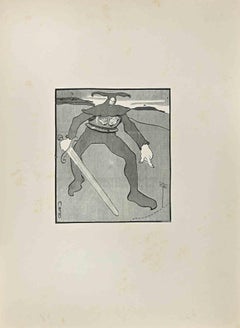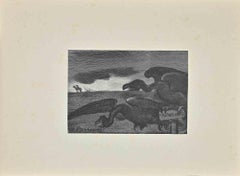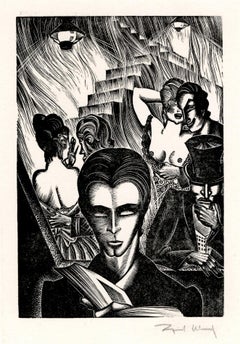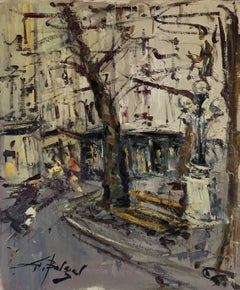Georges Berger Art
to
3
2
1
3
Overall Height
to
Overall Width
to
3
2
1
1
1
1
1
1
3
3
6,958
3,331
2,514
1,213
3
Artist: Georges Berger
The Warrior - Woodcut Print by Georges Berger - 20th Century
By Georges Berger
Located in Roma, IT
The Warrior is a woodcut print on paper realized by French artist in 1900s G. Berger.
Signed on the plate on the lower right.
The state of preservation is good with slight foxing.
...
Category
Early 20th Century Modern Georges Berger Art
Materials
Woodcut
Waiting Hyenas - Woodcut Print by Georges Berger - Early 20th Century
By Georges Berger
Located in Roma, IT
Waiting Hyenas is a woodcut print on paper realized by French artist in 1900s G. Berger.
Signed on the plate on the lower right.
The state of preservation is very good.
The artwo...
Category
Early 20th Century Modern Georges Berger Art
Materials
Woodcut
Shadowing Death - Woodcut Print by Georges Berger - Early 20th Century
By Georges Berger
Located in Roma, IT
Shadowing Death is a woodcut print on paper realized by French artist in 1900s G. Berger.
Signed on the plate on the lower right.
The state of preservation is very good.
The artwork represents the dark scenery of skulls and dead in a dark stormy...
Category
Early 20th Century Modern Georges Berger Art
Materials
Woodcut
Related Items
'Madman's Drum (Plate 41)' — 1930s Graphic Modernism
By Lynd Ward
Located in Myrtle Beach, SC
Lynd Ward, 'Madman's Drum, Plate 41', wood engraving, 1930, edition small. Signed in pencil. A fine, black impression, on off-white tissue-thin Japan paper; the full sheet with margins (1 5/8 to 2 1/2 inches); a small paper blemish in the upper right margin, away from the image, otherwise in excellent condition. Scarce. Matted to museum standards, unframed.
Image size 5 1/2 x 3 3/4 inches (140 x 95 mm); sheet size 9 5/8 x 7 1/8 inches (244 x 181 mm).
From Lynd Ward’s book of illustrations without words, 'Madman’s Drum', Jonathan Cape and Harrison Smith, New York, 1930. Illustrated in 'Storyteller Without Words: The Wood Engravings of Lynd Ward', Harry Abrams, New York, 1974.
Reproduced in 'Storyteller Without Words, the Wood Engravings of Lynd Ward', Harry N. Abrams, New York, 1974.
ABOUT THE ARTIST
Lynd Ward is acknowledged as one of America’s foremost wood engravers and book illustrators of the first half of the twentieth century. His innovative use of narrative printmaking as a stand-alone storytelling vehicle was uniquely successful in reaching a broad audience. The powerful psychological intensity of his work, celebrated for its dynamic design, technical precision, and compelling dramatic content, finds resonance in the literature of Poe, Melville, and Hawthorne. Like these classic American writers, Ward was concerned with the themes of man’s inner struggles and the role of the subconscious in determining his destiny. An artist of social conscience during the Great Depression and World War II, he infused his graphic images with his unique brand of social realism, deftly portraying the problems that challenged the ideals of American society.
The son of a Methodist preacher, Lynd Ward, moved from Chicago to Massachusetts at an early age. He graduated from the Teachers College of Columbia University, New York, in 1926, where he studied illustration and graphic arts. He married May Yonge McNeer in 1936 and left for Europe for their honeymoon in Eastern Europe. After four months, they settled in Leipzig, where Ward studied at the National Academy of Graphic Arts and Bookmaking. Inspired by Belgian expressionist artist Frans Masereel's graphic novel ‘The Sun,’ and another graphic novel by the German artist Otto Nückel, ‘Destiny,’ he determined to create his own "wordless" novel. Upon his return to America, Ward completed his first book, ‘God's Man: A Novel in Woodcuts,’ published in 1929. ‘Gods’ Man’ was a great success for its author and publisher and was reprinted four times in 1930, including a British edition. This book and several which followed it, ‘Madman’s Drum,’ 1930, ‘Wild Pilgrimage...
Category
1930s American Modern Georges Berger Art
Materials
Woodcut
'Simplicius' Farewell to the World' — Graphic Modernism
By Fritz Eichenberg
Located in Myrtle Beach, SC
Fritz Eichenberg, 'Simplicius’ Farewell To The World' from the suite 'The Adventurous Simplicissimus', wood engraving, 1977, artist's proof apart from the edition of 50. Signed in pencil. Signed in the block, lower right. A fine, richly-inked impression, on cream wove paper, with full margins (1 1/2 to 2 inches), in excellent condition. Image size 14 x 12 inches (356 x 305 mm); sheet size 17 1/2 x 15 inches (445 x 381 mm). Archivally sleeved, unmatted.
ABOUT THIS WORK
'Simplicius Simplicissimus' (German: Der abenteuerliche Simplicissimus Teutsch) is a picaresque novel of the lower Baroque style, written in five books by Hans Jakob Christoffel von Grimmelshausen published in 1668, with the sequel Continuatio appearing in 1669.
The novel is told from the perspective of its protagonist Simplicius, a rogue or picaro typical of the picaresque novel, as he traverses the tumultuous world of the Holy Roman Empire during the Thirty Years' War. Raised by a peasant family, he is separated from his home by foraging dragoons. He is adopted by a hermit living in the forest, who teaches him to read and introduces him to religion. The hermit also gives Simplicius his name because he is so simple that he does not know his own name. After the death of the hermit, Simplicius must fend for himself. He is conscripted at a young age into service and, from there, embarks on years of foraging, military triumph, wealth, prostitution, disease, bourgeois domestic life, and travels to Russia, France, and an alternate world inhabited by mermen. The novel ends with Simplicius turning to a life of hermitage, denouncing the world as corrupt.
ABOUT THE ARTIST
Fritz Eichenberg (1901–1990) was a German-American illustrator and arts educator who worked primarily in wood engraving. His best-known works were concerned with religion, social justice, and nonviolence.
Eichenberg was born to a Jewish family in Cologne, Germany, where the destruction of World War I helped to shape his anti-war sentiments. He worked as a printer's apprentice and studied at the Municipal School of Applied Arts in Cologne and the Academy of Graphic Arts in Leipzig, where he studied under Hugo Steiner-Prag. In 1923 he moved to Berlin to begin his career as an artist, producing illustrations for books and newspapers. In his newspaper and magazine work, Eichenberg was politically outspoken and sometimes wrote and illustrated his reporting.
In 1933, the rise of Adolf Hitler drove Eichenberg, who was a public critic of the Nazis, to emigrate with his wife and children to the United States. He settled in New York City, where he lived most of his life. He worked in the WPA Federal Arts Project and was a member of the Society of American Graphic Artists.
In his prolific career as a book illustrator, Eichenberg portrayed many forms of literature but specialized in works with elements of extreme spiritual and emotional conflict, fantasy, or social satire. Over his long career, Eichenberg was commissioned to illustrate more than 100 classics by publishers in the United States and abroad, including works by renowned authors Dostoyevsky, Tolstoy, Charlotte and Emily Brontë, Poe, Swift, and Grimmelshausen. He also wrote and illustrated books of folklore and children's stories.
Eichenberg was a long-time contributor to the progressive magazine The Nation, his illustrations appearing between 1930 and 1980. Eichenberg’s work has been featured by such esteemed publishers as The Heritage Club, Random House, Book of the Month Club, The Limited Editions Club, Kingsport Press, Aquarius Press, and Doubleday.
Raised in a non-religious family, Eichenberg had been attracted to Taoism as a child. Following his wife's unexpected death in 1937, he turned briefly to Zen Buddhist meditation, then joined the Religious Society of Friends in 1940. Though he remained a Quaker until his death, Eichenberg was also associated with Catholic charity work through his friendship with Dorothy Day...
Category
1970s American Modern Georges Berger Art
Materials
Woodcut
'The Pimp' — Graphic Modernism
By Fritz Eichenberg
Located in Myrtle Beach, SC
Fritz Eichenberg, 'The Pimp', wood engraving, 1980, artist's proof before the edition. Signed in pencil. Signed in the block, lower right. A fine, richly-inked impression, on cream wove paper, with full margins (2 3/16 to 3 1/2 inches), in excellent condition. Archivally sleeved, unmatted.
Image size 12 x 9 3/4 inches (305 x 248 mm); sheet size 18 x 14 inches (457 x 356 mm).
ABOUT THE ARTIST
Fritz Eichenberg (1901–1990) was a German-American illustrator and arts educator who worked primarily in wood engraving. His best-known works were concerned with religion, social justice, and nonviolence.
Eichenberg was born to a Jewish family in Cologne, Germany, where the destruction of World War I helped to shape his anti-war sentiments. He worked as a printer's apprentice and studied at the Municipal School of Applied Arts in Cologne and the Academy of Graphic Arts in Leipzig, where he studied under Hugo Steiner-Prag. In 1923 he moved to Berlin to begin his career as an artist, producing illustrations for books and newspapers. In his newspaper and magazine work, Eichenberg was politically outspoken and sometimes wrote and illustrated his reporting.
In 1933, the rise of Adolf Hitler drove Eichenberg, who was a public critic of the Nazis, to emigrate with his wife and children to the United States. He settled in New York City, where he lived most of his life. He worked in the WPA Federal Arts Project and was a member of the Society of American Graphic Artists.
In his prolific career as a book illustrator, Eichenberg portrayed many forms of literature but specialized in works with elements of extreme spiritual and emotional conflict, fantasy, or social satire. Over his long career, Eichenberg was commissioned to illustrate more than 100 classics by publishers in the United States and abroad, including works by renowned authors Dostoyevsky, Tolstoy, Charlotte and Emily Brontë, Poe, Swift, and Grimmelshausen. He also wrote and illustrated books of folklore and children's stories.
Eichenberg was a long-time contributor to the progressive magazine The Nation, his illustrations appearing between 1930 and 1980. Eichenberg’s work has been featured by such esteemed publishers as The Heritage Club, Random House, Book of the Month Club, The Limited Editions Club, Kingsport Press, Aquarius Press, and Doubleday.
Raised in a non-religious family, Eichenberg had been attracted to Taoism as a child. Following his wife's unexpected death in 1937, he turned briefly to Zen Buddhist meditation, then joined the Religious Society of Friends in 1940. Though he remained a Quaker until his death, Eichenberg was also associated with Catholic charity work through his friendship with Dorothy Day...
Category
1980s American Modern Georges Berger Art
Materials
Woodcut
Irving Amen, The Heart is a Garden, Signed A/P & Framed Woodblock Print
By Irving Amen
Located in Plainview, NY
A woodblock print in color, of a girl looking up at a giant flower bouquet by Irving Amen ( American, 1918-2011) . The lithograph entitled "The Heart is a Garden " is signed Amen and...
Category
20th Century Modern Georges Berger Art
Materials
Woodcut
H 34 in W 25 in D 1.5 in
Wedding Party
Located in Buffalo, NY
An original mid century modern woodblock print.
This work is hand signed illegibly and titled "Wedding Party".
Category
1960s Modern Georges Berger Art
Materials
Paper, Woodcut
Angor Vhat.
By Elyse Ashe Lord
Located in Storrs, CT
Angor Vhat. 1930. Woodcut and drypoint printed in colors. 11 x 13 (sheet 15 7/8 x 16 7/8). Edition 75, # 22. A bright, colorful impression printed on Japanese mulberry paper, with an irregular bottom margin. Signed and numbered in pencil. Housed in a 18 3/8 4 x 19 1/2-inch archival mat, suitable for framing.
----------------------------------------------------------------------------------------------------
Elyse Ashe Lord was a British artist and illustrator who worked in watercolors and drypoint etching. She studied at the Heatherley School of Art in Chelsea. The first public exhibition of her work was in 1919. Her drawings were exhibited at the Brook Street Gallery in 1921.[ In 1922 she became a member of the Royal Institute of Painters in Water Colours. Various large exhibitions of her works were held during her lifetime.
Her images typically draw on the Art Deco movement and ideas of Oriental culture, despite the fact that she never visited the Far East. She was a popular artist, even during a time period when the art market, and decorative arts particularly, was suffering from the economic crisis of the 1930s. She lived in Bexley in Kent.
----------------------------------------------------------------------------------------------
Angkor Wat, in its beauty and state of preservation, is unrivaled. Its mightiness and magnificence bespeak a pomp and a luxury surpassing that of a Pharaoh or a Shah Jahan, an impressiveness greater than that of the Pyramids, an artistic distinctiveness as fine as that of the Taj Mahal. Angkor Wat is located about six kilometers (four miles) north of Siem Reap, south of Angkor Thom...
Category
1920s Modern Georges Berger Art
Materials
Color, Drypoint, Woodcut
'City Lights' — Vintage Wood Engraving, New York City, 1934
By Fritz Eichenberg
Located in Myrtle Beach, SC
Fritz Eichenberg, 'City LIghts', wood engraving, 1934, edition 200. Signed, titled 'Lights', and annotated 'No 2/200 for Howard M. Chapin' in pencil. Initialed in the block, lower right. A fine, richly-inked black impression, on cream wove paper, with full margins (1 1/4 to 1 7/8 inches); a small loss (5/8 inch) in the top right sheet corner, well away from the image, otherwise in excellent condition. Printed by master printer Ernest Roth...
Category
1930s American Modern Georges Berger Art
Materials
Woodcut
Animals All: WHO WERE THE FIRST TO CRY NOWELL ANIMALS ALL AS IT BEFELL.
By Eric Gill
Located in Storrs, CT
Animals All: WHO WERE THE FIRST TO CRY NOWELL ANIMALS ALL AS IT BEFELL. 1916. Woodcut. Physick 51. 14 7/8 x 16 3/8 (sheet 25 x 27 ). No published edition. Printed on simili-Japan pa...
Category
Early 20th Century Modern Georges Berger Art
Materials
Woodcut
H 26.5 in W 28.5 in D 2 in
Schwarze Madonna
Located in Wien, 9
Auguste Kronheim was born in Amsterdam in 1937. The artist makes woodcuts and drawings. She received her training in drawing from Hanns Kobinger and graduated from the Linz Federal T...
Category
20th Century Modern Georges Berger Art
Materials
Woodcut
On the Beach (Coney Island, New York) — 1930s Graphic Modernism, WPA
By Lou Barlow
Located in Myrtle Beach, SC
Lou Barlow (Louis Breslow), 'On the Beach' (Coney Island) wood engraving, c. 1937, edition c. 25. Signed and titled in pencil. Stamped 'FEDERAL ART PROJECT NYC WPA' in the bottom left margin. A fine, richly-inked impression, with all the fine lines printing clearly, on cream wove paper, with full margins (1 1/2 to 3 inches), in excellent condition. Matted to museum standards, unframed. Scarce.
Image size 11 x 8 1/8 inches; sheet size 16 x 11 3/8 inches.
Created during the Great Depression for the Works Progress Administration (WPA), Federal Art Project, New York City.
Impressions of this work are in the permanent collections of the Illinois State Museum and the New York Public Library.
ABOUT THE IMAGE
Due to Coney Island's proximity to Manhattan, Brooklyn, and other New York boroughs, it began attracting vacationers in the 1830s and 1840s. Most of the vacationers were wealthy and went by carriage roads and steamship services that reduced travel time from a formerly half-day journey to two hours. By the late 1870s, the development of Coney Island's amusement park attractions and hotels drew people from all social classes. When the Brooklyn Rapid Transit Company electrified the steam railroads and connected Brooklyn to Manhattan via the Brooklyn Bridge at the beginning of the 20th century, Coney Island turned rapidly from a resort to an accessible location for day-trippers seeking to escape the summer heat in New York City's tenements. In 1915, the Sea Beach Line was upgraded to a subway line, and the opening of the Stillwell Avenue station in 1919 ushered in Coney Island's busiest era. On the peak summer days, over a million people would travel to Coney Island. In 1937, New York City purchased a 400-foot-wide strip of land along the shoreline to allow the boardwalk to be moved 300 feet inland. At this point, Coney Island was so crowded on summer weekends that parks commissioner Robert Moses...
Category
1930s American Modern Georges Berger Art
Materials
Woodcut
'Run Little Chillun' also 'Revival' — African American Subject
Located in Myrtle Beach, SC
Isac Friedlander, 'Run Little Chillun' also 'Revival', wood engraving, 1933, edition 50. Signed, titled and annotated 'New York 1933' in pencil. A sup...
Category
1930s American Modern Georges Berger Art
Materials
Woodcut
Shift Change, Social Realist Woodblock Print by Mike Goscinsky
Located in Long Island City, NY
Shift Change
Mike Goscinsky, American (1933–2021)
Woodblock on thin wove paper, signed, titled and numbered in pencil
Edition of 15/75
Image Size: 14 x 19 inches
Size: 22 x 26.5 in. ...
Category
1990s American Modern Georges Berger Art
Materials
Woodcut
Previously Available Items
Mid Century French Post-Impressionist Signed Oil - Montmartre Paris Street Scene
By Georges Berger
Located in Cirencester, Gloucestershire
"Montmartre"
by Georges Berger (French 1908-1976)
signed, lower left
oil painting on canvas, unframed
canvas: 55cm x 46cm
Superb Parisian oil painting...
Category
Mid-20th Century Post-Impressionist Georges Berger Art
Materials
Canvas, Oil
GRAND BOULEVARDS, PARIS
By Georges Berger
Located in Los Angeles, CA
GEORGES BERGER
"GRAND BOULEVARDS, PARIS"
OIL ON CANVAS, SIGNED
FRANCE, C.1940
21.5 X 18 INCHES
Georges Berger
Born 24 January 1908 , in Paris ; died 1976...
Category
1940s Post-Impressionist Georges Berger Art
Materials
Canvas, Oil
Georges Berger art for sale on 1stDibs.
Find a wide variety of authentic Georges Berger art available for sale on 1stDibs. You can also browse by medium to find art by Georges Berger in woodcut print and more. Much of the original work by this artist or collective was created during the 20th century and is mostly associated with the modern style. Not every interior allows for large Georges Berger art, so small editions measuring 12 inches across are available. Customers who are interested in this artist might also find the work of Jacques Beltrand, Felix Labisse, and Eugene Corneau. Georges Berger art prices can differ depending upon medium, time period and other attributes. On 1stDibs, the price for these items starts at $223 and tops out at $312, while the average work can sell for $245.






